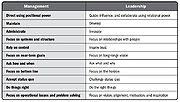Motivation through Theory X&Y from a Project Management perspective
Developed by Marie Elly Ulricke Kristensen
Contents |
Abstract
In the 1950s large-scale, complex, and interdisciplinary projects emerged. Along with the new trend in project format, new materials, procedures, and methods were developed to support the success of these [1]. Thus, paving the way for projects to be more focused on the Socio-technical aspects and the importance of soft skills [1].
As projects have continued to become more complicated, this has proven the project manager's importance in leading projects to success [2]. A project manager may have the necessary skills to guide a project team through various project stages and project life cycles, nevertheless team motivation is an essential element of a successful project [3]. Thus, making the ability to motivate a team an important leadership skill for project managers [2].
The idea that a manager’s attitude has an impact on employee motivation was initially suggested by Douglas Murray McGregor (1906-1964), a Professor of Management at the MIT Sloan School of Management in the late 1930’s and 1940’s [4]. In 1960, McGregor released the book, The Human Side of Enterprise, which proposed two theories by which mangers perceive and address employee motivation [4]. The two antagonistic motivational methods are referred to as Theory X and Theory Y and splits corporate thinking into two camps in their embodiment of attitudes and assumptions [4]. Theory X assumes individuals to require constant attention and punishment to achieve the desired outcome, whereas Theory Y assumes individuals to seek opportunities and improvement, thereby not requiring a controlling environment [5].
This article will start by introducing the relevant background to the initiation of Theory X and Theory Y, followed by an introduction to the two different motivational methods, their theoretical framework, and how this reflects in the role of a project manager. The article will then introduce the different advantages and disadvantages of each of the motivational methods from a management perspective as well as reflect on the criticism of Theory X and Theory Y. Lastly the article will reflect on the complex work environment in context to choosing a management style based on the motivational theories proposed by McGregor.
Background
Theory X
Hard and Soft Approach
Criticism of Theory X
Theory Y
Management Implications
Criticism of Theory Y
Management roles and responsibilities

Advantages
Disadvantages
Choosing a management style
Limitations
Annotated bibliography
The following list provides resources for further research and study on Theory X and Y:
- Last name, First name (Year): Title
- - Comment.
References
- ↑ 1.0 1.1 Zûst, R. & Troxler, P. (2006). Communication. No More Muddling Through – Master Compelx Projects in Engineering and Management. Published by Springer Netherlands. ISBN: 978-1-4020-5018-3.
- ↑ 2.0 2.1 2.2 Project Management Institute, Inc.. (2017). Guide to the Project Management Body of Knowledge (PMBOK® Guide) (6th Edition). Project Management Institute, Inc. (PMI). Retrieved from: https://app.knovel.com/hotlink/toc/id:kpGPMBKP02/guide-project-management/guide-project-management.
- ↑ Schmid, B., Adams, J. Motivation in Project Management: The Project Manager’s Perspective. [1]. Project Management Journal. Issue published: June 1, 2008. Volume: 39, issue: 2, p. 60-71.
- ↑ 4.0 4.1 4.2 MIT Institute for Work and Employment Research: Douglas M. McGregor. [2]. Accessed 13-02-2021.
- ↑ Peterson, T. M. Motivation: How to Increase Project Team Performance. [3]. Project Management Journal. Issue published: December 1, 2007. Volume: 38, issue: 4, p. 60-69